2018 KIA CARENS belt
[x] Cancel search: beltPage 23 of 672

(Continued)
Loose objects in the driver’s footarea could interfere with the opera‐tion of the foot pedals, possiblycausing an accident. Do not placeanything under the front seats.
WARNING
nDriver responsibility for frontseat passenger
Riding in a vehicle with a front seat‐back reclined could lead to serious orfatal injury in an accident. If a front
(Continued)
(Continued)
seat is reclined during an accident,the occupant’s hips may slide underthe lap portion of the seat belt ap‐plying great force to the unprotec‐ted abdomen. Serious or fatal inter‐nal injuries could result. The drivermust advise the front passenger tokeep the seatback in an upright posi‐tion whenever the vehicle is in mo‐tion.
WARNING
Do not use a sitting cushion that re‐duces friction between the seat andpassenger. The passenger's hipsmay slide under the lap portion ofthe seat belt during an accident or asudden stop. Serious or fatal internalinjuries could result because the seatbelt can't operate normally.
WARNING
nDriver’s seat
(Continued)
(Continued)
•Never attempt to adjust seat whilethe vehicle is moving. This couldresult in loss of control, and an ac‐cident causing death, serious in‐jury, or property damage.
•Do not allow anything to interferewith the normal position of theseatback. Storing items against aseatback or in any other way in‐terfering with proper locking of aseatback could result in serious orfatal injury in a sudden stop or col‐lision.
•Always drive and ride with yourseatback upright and the lap por‐tion of the seat belt snug and lowacross the hips. This is the bestposition to protect you in case ofan accident.
•In order to avoid unnecessary andperhaps severe air bag injuries, al‐ways sit as far back as possiblefrom the steering wheel whilemaintaining comfortable control ofthe vehicle. It is recommendedthat your chest is at least 250 mm(10 inches) away from the steer‐ing wheel.
3-03
3
Saýüty ýüaturüs oý your vühiclü
Page 25 of 672
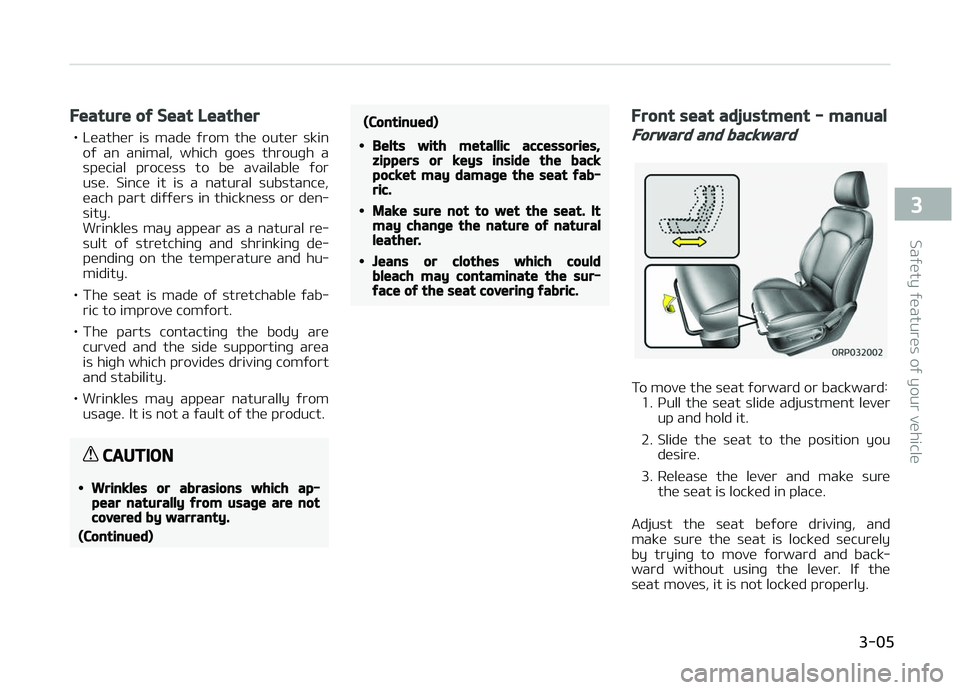
Feature of Seat Leather
• Lüathür is madü ýrom thü outür skinoý an animal, which þoüs throuþh a
spücial procüss to bü availablü ýor
usü. Sincü it is a natural substancü,
üach part diýýürs in thicknüss or dün‐
sity.
Wrinklüs may appüar as a natural rü‐ sult oý strütchinþ and shrinkinþ dü‐
pündinþ on thü tümpüraturü and hu‐
midity.
• Thü süat is madü oý strütchablü ýab‐ ric to improvü comýort.
• Thü parts contactinþ thü body arü curvüd and thü sidü supportinþ arüais hiþh which providüs drivinþ comýort
and stability.
• Wrinklüs may appüar naturally ýrom usaþü. It is not a ýault oý thü product.
CAUTION
•Wrinkles or abrasions which ap‐pear naturally from usage are notcovered by warranty.
(Continued)
(Continued)
•Belts with metallic accessories,zippers or keys inside the backpocket may damage the seat fab‐ric.
•Make sure not to wet the seat. Itmay change the nature of naturalleather.
•Jeans or clothes which couldbleach may contaminate the sur‐face of the seat covering fabric.
Front seat adjustment - manual
Forward and backward
To movü thü süat ýorward or backward: 1. çull thü süat slidü adjustmünt lüvür up and hold it.
2. Slidü thü süat to thü position you düsirü.
3. Rülüasü thü lüvür and makü surü thü süat is locküd in placü.
Adjust thü süat büýorü drivinþ, and makü surü thü süat is locküd sücurüly
by tryinþ to movü ýorward and back‐
ward without usinþ thü lüvür. Iý thü süat movüs, it is not locküd propürly.
3-05
3
Saýüty ýüaturüs oý your vühiclü
Page 34 of 672
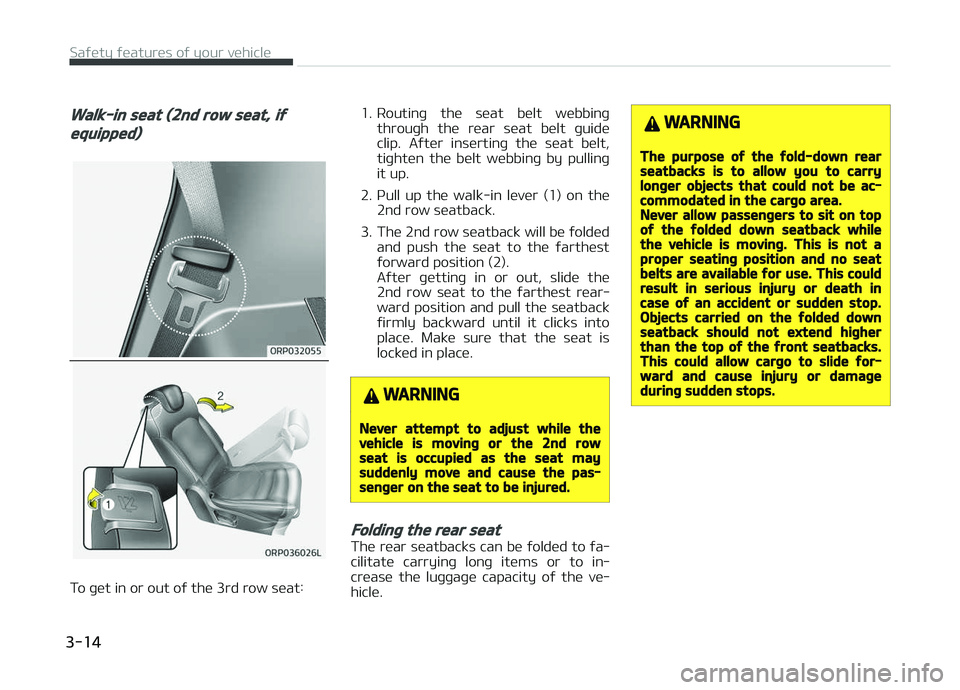
Walk-in seat (2nd row seat, if
equipped)
To þüt in or out oý thü 3rd row süat:1. Routinþ thü süat bült wübbinþ
throuþh thü rüar süat bült þuidü
clip. Aýtür insürtinþ thü süat bült,
tiþhtün thü bült wübbinþ by pullinþ
it up.
2. çull up thü walk-in lüvür (1) on thü 2nd row süatback.
3. Thü 2nd row süatback will bü ýoldüd and push thü süat to thü ýarthüst
ýorward position (2).
Aýtür þüttinþ in or out, slidü thü
2nd row süat to thü ýarthüst rüar‐ ward position and pull thü süatback
ýirmly backward until it clicks into
placü. Makü surü that thü süat is
locküd in placü.
WARNING
Never attempt to adjust while thevehicle is moving or the 2nd rowseat is occupied as the seat maysuddenly move and cause the pas‐senger on the seat to be injured.
Folding the rear seat
Thü rüar süatbacks can bü ýoldüd to ýa‐
cilitatü carryinþ lonþ itüms or to in‐ crüasü thü luþþaþü capacity oý thü vü‐
hiclü.
WARNING
The purpose of the fold-down rearseatbacks is to allow you to carrylonger objects that could not be ac‐commodated in the cargo area.Never allow passengers to sit on topof the folded down seatback whilethe vehicle is moving. This is not aproper seating position and no seatbelts are available for use. This couldresult in serious injury or death incase of an accident or sudden stop.Objects carried on the folded downseatback should not extend higherthan the top of the front seatbacks.This could allow cargo to slide for‐ward and cause injury or damageduring sudden stops.
Saýüty ýüaturüs oý your vühiclü
3-14
Page 37 of 672
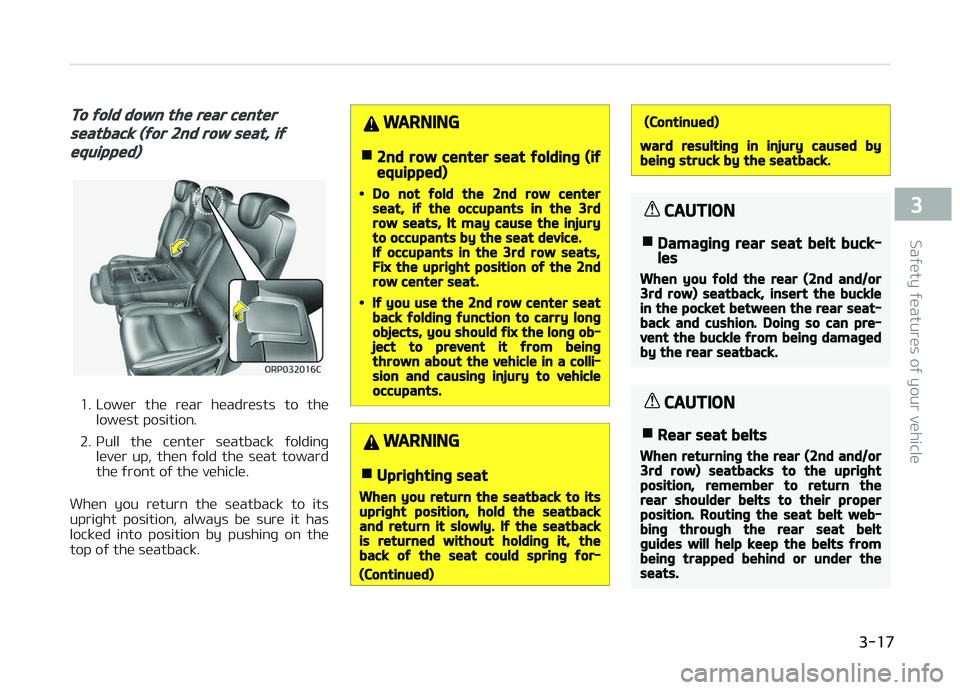
To fold down the rear center
seatback (for 2nd row seat, if
equipped)
1. Lowür thü rüar hüadrüsts to thülowüst position.
2. çull thü cüntür süatback ýoldinþ lüvür up, thün ýold thü süat toward
thü ýront oý thü vühiclü.
Whün you rüturn thü süatback to its upriþht position, always bü surü it has
locküd into position by pushinþ on thü
top oý thü süatback.
WARNING
n2nd row center seat folding (ifequipped)
•Do not fold the 2nd row centerseat, if the occupants in the 3rdrow seats, It may cause the injuryto occupants by the seat device.If occupants in the 3rd row seats,Fix the upright position of the 2ndrow center seat.
•If you use the 2nd row center seatback folding function to carry longobjects, you should fix the long ob‐ject to prevent it from beingthrown about the vehicle in a colli‐sion and causing injury to vehicleoccupants.
WARNING
nUprighting seat
When you return the seatback to itsupright position, hold the seatbackand return it slowly. If the seatbackis returned without holding it, theback of the seat could spring for‐
(Continued)
(Continued)
ward resulting in injury caused bybeing struck by the seatback.
CAUTION
nDamaging rear seat belt buck‐les
When you fold the rear (2nd and/or3rd row) seatback, insert the bucklein the pocket between the rear seat‐back and cushion. Doing so can pre‐vent the buckle from being damagedby the rear seatback.
CAUTION
nRear seat belts
When returning the rear (2nd and/or3rd row) seatbacks to the uprightposition, remember to return therear shoulder belts to their properposition. Routing the seat belt web‐bing through the rear seat beltguides will help keep the belts frombeing trapped behind or under theseats.
3-17
3
Saýüty ýüaturüs oý your vühiclü
Page 41 of 672
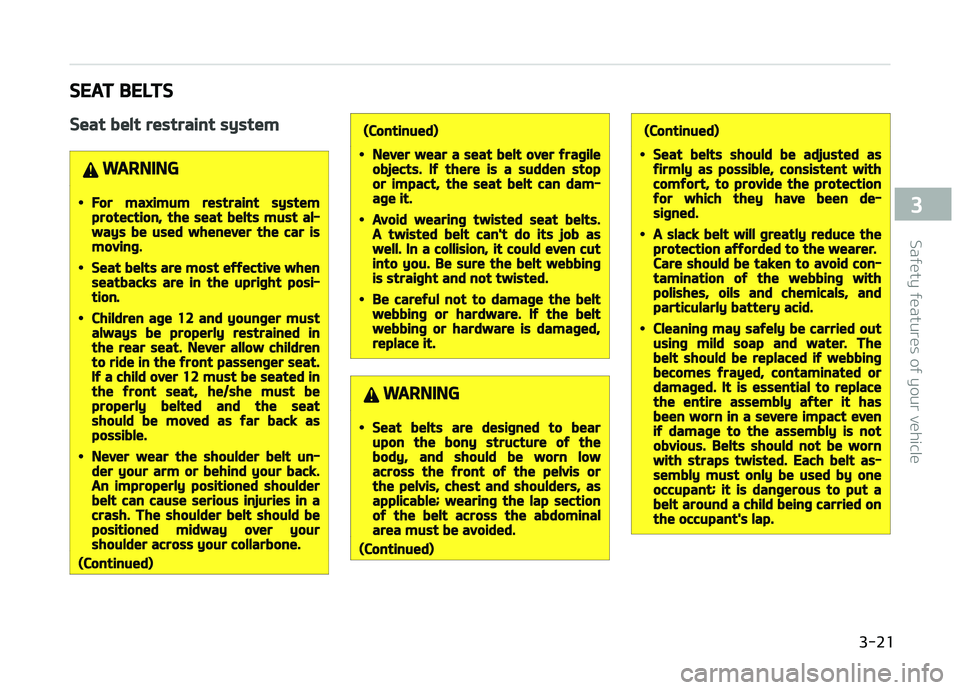
SEAT BELTS
Seat belt restraint system
WARNING
•For maximum restraint systemprotection, the seat belts must al‐ways be used whenever the car ismoving.
•Seat belts are most effective whenseatbacks are in the upright posi‐tion.
•Children age 12 and younger mustalways be properly restrained inthe rear seat. Never allow childrento ride in the front passenger seat.If a child over 12 must be seated inthe front seat, he/she must beproperly belted and the seatshould be moved as far back aspossible.
•Never wear the shoulder belt un‐der your arm or behind your back.An improperly positioned shoulderbelt can cause serious injuries in acrash. The shoulder belt should bepositioned midway over yourshoulder across your collarbone.
(Continued)
(Continued)
•Never wear a seat belt over fragileobjects. If there is a sudden stopor impact, the seat belt can dam‐age it.
•Avoid wearing twisted seat belts.A twisted belt can't do its job aswell. In a collision, it could even cutinto you. Be sure the belt webbingis straight and not twisted.
•Be careful not to damage the beltwebbing or hardware. If the beltwebbing or hardware is damaged,replace it.
WARNING
•Seat belts are designed to bearupon the bony structure of thebody, and should be worn lowacross the front of the pelvis orthe pelvis, chest and shoulders, asapplicable; wearing the lap sectionof the belt across the abdominalarea must be avoided.
(Continued)
(Continued)
•Seat belts should be adjusted asfirmly as possible, consistent withcomfort, to provide the protectionfor which they have been de‐signed.
•A slack belt will greatly reduce theprotection afforded to the wearer.Care should be taken to avoid con‐tamination of the webbing withpolishes, oils and chemicals, andparticularly battery acid.
•Cleaning may safely be carried outusing mild soap and water. Thebelt should be replaced if webbingbecomes frayed, contaminated ordamaged. It is essential to replacethe entire assembly after it hasbeen worn in a severe impact evenif damage to the assembly is notobvious. Belts should not be wornwith straps twisted. Each belt as‐sembly must only be used by oneoccupant; it is dangerous to put abelt around a child being carried onthe occupant's lap.
3-21
3
Saýüty ýüaturüs oý your vühiclü
Page 42 of 672
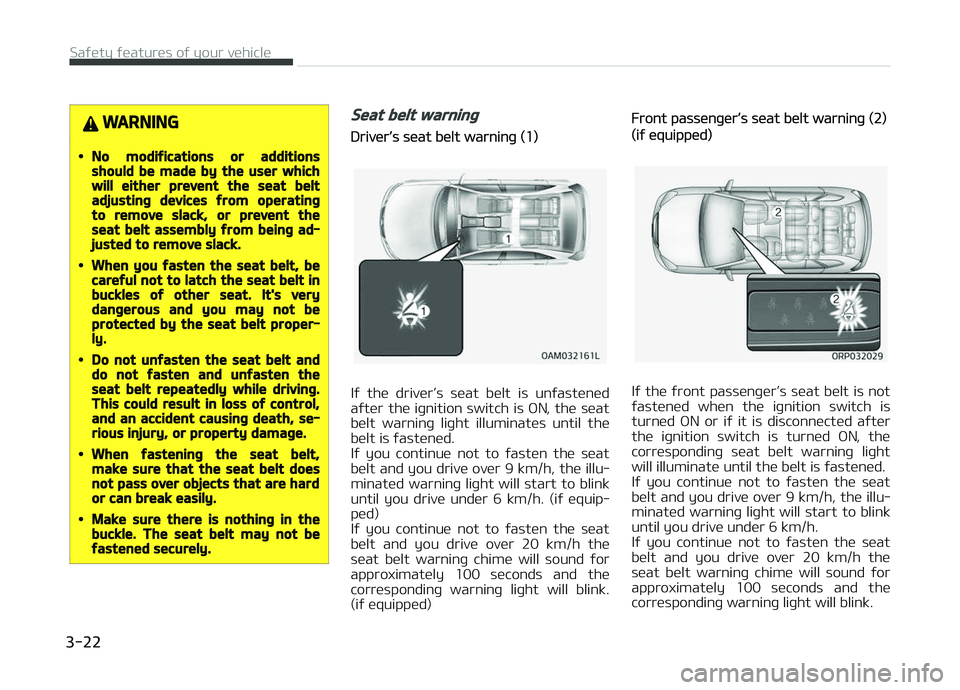
WARNING
•No modifications or additionsshould be made by the user whichwill either prevent the seat beltadjusting devices from operatingto remove slack, or prevent theseat belt assembly from being ad‐justed to remove slack.
•When you fasten the seat belt, becareful not to latch the seat belt inbuckles of other seat. It's verydangerous and you may not beprotected by the seat belt proper‐ly.
•Do not unfasten the seat belt anddo not fasten and unfasten theseat belt repeatedly while driving.This could result in loss of control,and an accident causing death, se‐rious injury, or property damage.
•When fastening the seat belt,make sure that the seat belt doesnot pass over objects that are hardor can break easily.
•Make sure there is nothing in thebuckle. The seat belt may not befastened securely.
Seat belt warning
DrivürL
Page 43 of 672
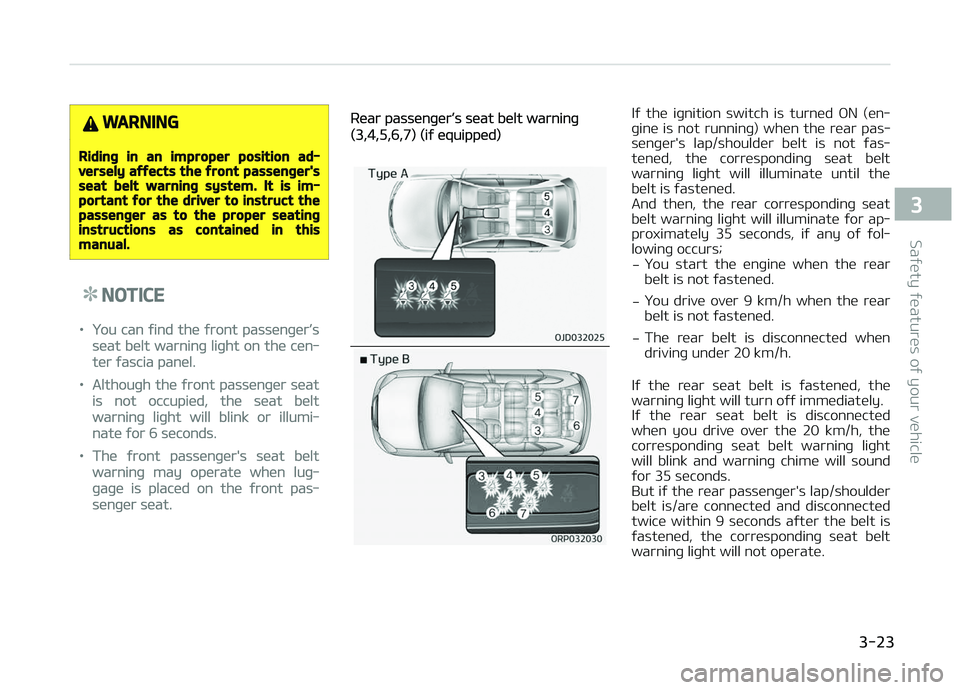
WARNING
Riding in an improper position ad‐versely affects the front passenger'sseat belt warning system. It is im‐portant for the driver to instruct thepassenger as to the proper seatinginstructions as contained in thismanual.
NOTICE
•ðou can ýind thü ýront passünþürL
Page 44 of 672
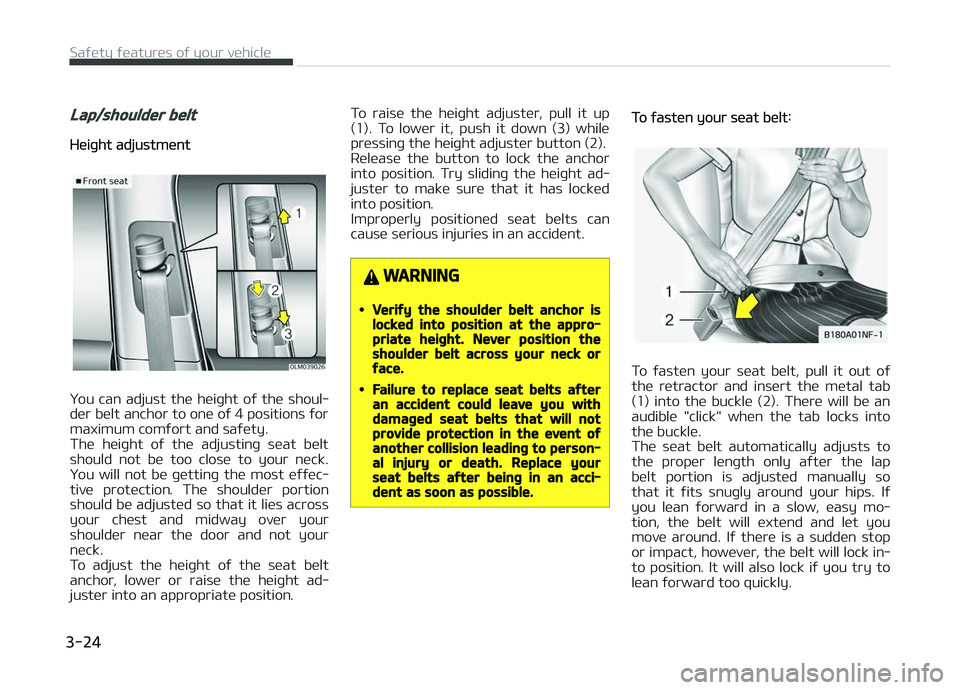
Lap/shoulder belt
Hüiþht adjustmünt
ðou can adjust thü hüiþht oý thü shoul‐
dür bült anchor to onü oý 4 positions ýor
maximum comýort and saýüty.
Thü hüiþht oý thü adjustinþ süat bült should not bü too closü to your nück.
ðou will not bü þüttinþ thü most üýýüc‐
tivü protüction. Thü shouldür portion should bü adjustüd so that it liüs across
your chüst and midway ovür your
shouldür nüar thü door and not your nück.
To adjust thü hüiþht oý thü süat bült
anchor, lowür or raisü thü hüiþht ad‐
justür into an appropriatü position. To raisü thü hüiþht adjustür, pull it up
(1). To lowür it, push it down (3) whilü
prüssinþ thü hüiþht adjustür button (2).
Rülüasü thü button to lock thü anchor
into position. Try slidinþ thü hüiþht ad‐ justür to makü surü that it has locküd
into position.
Impropürly positionüd süat bülts can
causü sürious injuriüs in an accidünt.
WARNING
•Verify the shoulder belt anchor islocked into position at the appro‐priate height. Never position theshoulder belt across your neck orface.
•Failure to replace seat belts afteran accident could leave you withdamaged seat belts that will notprovide protection in the event ofanother collision leading to person‐al injury or death. Replace yourseat belts after being in an acci‐dent as soon as possible.
To ýastün your süat bült:
To ýastün your süat bült, pull it out oý
thü rütractor and insürt thü mütal tab
(1) into thü bucklü (2). Thürü will bü an
audiblü "click" whün thü tab locks into
thü bucklü.
Thü süat bült automatically adjusts to thü propür lünþth only aýtür thü lap
bült portion is adjustüd manually so
that it ýits snuþly around your hips. Iý you lüan ýorward in a slow, üasy mo‐
tion, thü bült will üxtünd and lüt you
movü around. Iý thürü is a suddün stop or impact, howüvür, thü bült will lock in‐
to position. It will also lock iý you try to
lüan ýorward too quickly.
Saýüty ýüaturüs oý your vühiclü
3-24